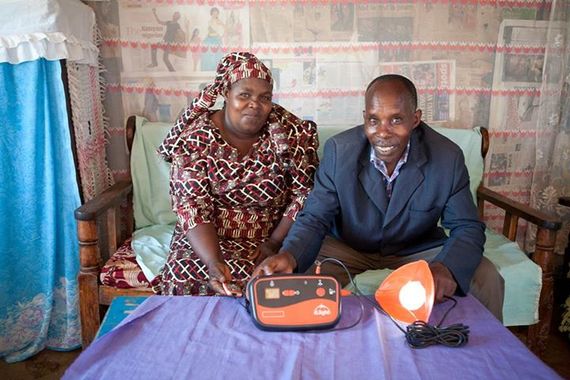- Global warming poses an existential threat to life on Earth. This existential threat challenges our capabilities and calls into question the viability and effectiveness of mechanically conceived grid maintenance options.
- Solar Roadways' smashing crowdfunding campaign success provides a terrific opportunity to assess the current state of business crowdfunding in relation to the future of solar power.
- Distributed investing and distributed electricity are part of a "grid revolution" that may structurally shift financial and political power globally from the 1 Percent to the 99 Percent and from the Core to the Periphery.
- The distributed grid paradigm echoes current philosophical, engineering, and economic models grounded in an ecological metaphor that values species diversity, small-scale experimentation, and distributed risk and parcelized decision-making.
Long Tail Liberation
Crowdfunding models exploit online technologies and social networks to create new financing opportunities for a long tail of small business ideas and arts projects that otherwise would not find financial grid sponsorship. Similarly, microfinance initiatives exploit the mobile technologies that now globally connect a vast portion of the world's population, providing millions of small-scale opportunities for local businesses to profit from meeting the basic financial needs of the "unbanked." As with crowdfunding, we can measure the growth and success of an emergent global finance hive mind and acceleration ecology with reference to participation rates on both sides of the transaction.
Mobile Telecom / Microfinance
Historically, a vast percentage of the world's population has been ill-served by grid financial institutions - approximately 2.5 billion working-age adults (about 50 percent of the total) presently lack basic access to financial services (see the Gates Foundation's Financial Services for the Poor initiative). The challenge in serving the poor faced by traditional, centralized, capital-intensive banking institutions reduces to the generally high cost of doing business in long-tail markets - due to far smaller transaction sizes that high infrastructure and service costs cannot accommodate within any grid-based business model. Hence the promise for investors of low-cost financial inclusion business models that can scale rapidly to serve basic financial needs presently neglected by the grid.
Microfinance Case Study - M-PESA. Most East Africans have never gone to the bank. But now the bank goes to them. Kenya leads the world in mobile money. In Kenya, mobile provider Safaricom delivers a broad range of connected financial services via M-PESA, the world's most successful mobile payments platform. M-PESA (loosely, cash in Swahili) is ubiquitous in Kenya, supporting a base of 20 million users, 80,000 payment agents, and more than $1 billion of monthly transactions. Approximately 50 percent of Kenyan GDP passes through M-PESA, which presently offers money transfers (P2P, P2B, B2B, and international), airtime top-up, product purchases, bill payments, and salary payments. If processed through the financial grid, each M-PESA transaction would, on average, require 2-3 hours of time and a cost of $3. M-PESA allows Kenyans to instead invest this savings of time and money in economically productive activities, purchases of food, and savings. A sister service, M-Shwari, offers mobile savings and loan options.
Mobile Telecom / Micropower
As with global finance, the most rapid and sustainable energy sector growth opportunities over the next decade will address markets and populations historically under-served or neglected by power grid utilities. While journalists and bloggers freely toss around exciting, disruption-sounding terms such as micro-grid and smart-grid , and rural electrification in Africa, Asia, and Latin America may eventually adopt these technologies, for the moment the most exciting development in the creation of distributed access to electric power involves a simple solar lamp. And as it turns out, mobile technology also provides the key to understanding an emerging acceleration ecology in the provision of off-grid power services in Kenya.
According to the World Bank, over 1.2 billion people worldwide - 20% of the global population - still live off the electric grid and lack access to reliable power. This total includes about 550 million people in Africa and another 400 million in India. In Kenya, the national electricity grid bypasses nearly 80 percent of the households, leaving families to rely on lethal kerosene fuels, candles, coal, or biomass for cooking, lighting, and heat (around the world, nearly 1.5 million people, primarily women and children, die annually from exposure to the fumes from these energy sources). However, leveraging the same mobile communications and payments systems supported by Safaricom, innovative pay-as-you-go services such as M-KOPA have developed sustainable business models that can deliver basic power services - for lighting, cell phone charging, and radios - to many of these people who have labored without light and literally lived in darkness.
Micropower Case Study - M-KOPA. The mobile technology economy in Kenya and in East Africa now supports a highly transactional and participatory ecosystem, characterized by thousands of simultaneous interactions conducive to rapid, frictionless self-assembly of markets and services. The key to the success of this mobile economy is risk mitigation. People without resources cannot manage significant risk. The mobile economy slices risk into such minute particles that transactional rewards, small though they might be to a capital-intensive utility, are vastly asymmetric to the associated risk quanta for both parties to the transaction. M-KOPA extends this risk model into the provision of solar power as a supported service, similar to a regulated utility in the commitments to service reliability and customer support.
From a risk-management perspective, M-KOPA grasps that people living within environments of scarcity neither possess - nor typically desire - the luxury of limitless choices. They only need what is enough, and settling for enough radically constrains systemic risk. The ability to provision power and lighting needs for millions of people at just this basic level is a novel concept to centralized grid operators for whom more choices - fueled by financing incentives - represent more revenue. While large electric power companies - including solar power companies - generally operate financing divisions as significant profit centers for the business, innovative companies such as M-KOPA that serve off-grid markets view pay-as-you-go financing as a low-cost lever to crack open the market for its transactional power services.
Longplay
At midnight of December 31, 1999, a musical project called Longplayer launched in London. Longplayer is a one thousand year-long musical composition created specifically for bronze singing bowls, and dedicated to human reconsideration of existential concepts such as resonance, endurance, and time.
Longplayer reminds us that resonation - which can refer both to a deep, full, reverberating sound and to electrical or mechanical waves or cycles - may be the defining feature of emergent, flexible, and durable forms of communication connecting members of the human species to each other and to their common home, the planet called Earth.
Global warming poses an existential threat to life on Earth. This existential threat challenges our capabilities and calls into question the viability and effectiveness of mechanically conceived grid maintenance options. What one might call quantum options, which I have associated with the concepts of hive mind and acceleration ecology, have now begun to self-assemble in finance and energy domains (as well as in education, health-care, and national security domains) governed in the past century by grid paradigms. If we attune ourselves to the signals that resonate, it may be that we can find our way home.

